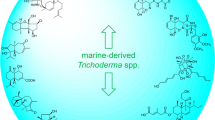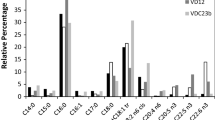Abstract
To explore the metabolic responses of marine-derived Trichoderma fungi to environmental stresses, the survivability, metabolism, and antagonism of ten marine isolates have been examined. Their survival in both freshwater and seawater indicates them to be facultative marine fungi, but they are more adaptable to marine environment. Most of them feature strain-specific and positive metabolic responses to seawater, which also usually result in the higher proportions of heteroatom-bearing and unsaturated units in mycelial constituents. Seawater factors can promote many strains to produce bioactive metabolites, including plant pathogen- and marine phytoplankton-inhibitory and marine animal-toxic ones, but the effects of NaCl are often weak or negative. The inhibition of marine phytoplankton corresponds to the intracellular accumulation of heteroatom-bearing and unsaturated units under seawater condition, and the varied toxicities to marine animals further signify the divergences of lipophilic exudates under different conditions. The results may contribute to further understanding and mining the structural diversity and biological activity of secondary metabolites from marine-derived Trichoderma fungi.
Similar content being viewed by others
References
Blunt J W, Carroll A R, Copp B R, Davis R A, Keyzers R A, Prinsep M R. 2018. Marine natural products. Nat. Prod. Rep., 35 (1): 8–53.
Bugni T S, Ireland C M. 2004. Marine–derived fungi: a chemically and biologically diverse group of microorganisms. Nat. Prod. Rep., 21 (1): 143–163.
Cacciola S O, Puglisi I, Faedda R, Sanzaro V, Pane A, Lo Piero A R, Evoli M, Petrone G. 2015. Cadmium induces cadmium–tolerant gene expression in the filamentous fungus Trichoderma harzianum. Mol. Biol. Rep., 42 (11): 1 559–1 570.
Chen C Y, Imamura N, Nishijima M, Adachi K, Sakai M, Sano H. 1996. Halymecins, new antimicroalgal substances produced by fungi isolated from marine algae. J. Antibiot., 49 (10): 998–1 005.
Chen L, Zhong P, Pan J R, Zhou K J, Huang K, Fang Z X, Zhang Q Q. 2013. Asperelines G and H, two new peptaibols from the marine–derived fungus Trichoderma asperellum. Heterocycles, 87 (3): 645–655.
Garo E, Starks C M, Jensen P R, Fenical W, Lobkovsky E, Clardy J. 2003. Trichodermamides A and B, cytotoxic modified dipeptides from the marine–derived fungus Trichoderma virens. J. Nat. Prod., 66 (3): 423–426.
Ghisalberti E L, Sivasithamparam K. 1991. Antifungal antibiotics produced by Trichoderma spp. Soil Biol. Biochem., 23 (11): 1 011–1 020.
Harman G E, Howell C R, Viterbo A, Chet I, Lorito M. 2004. Trichoderma species—opportunistic, avirulent plant symbionts. Nat. Rev. Microbiol., 2 (1): 43–56.
Ji N Y, Wang B G. 2016. Mycochemistry of marine algicolous fungi. Fungal Divers., 80 (1): 301–342.
Keswani C, Mishra S, Sarma B K, Singh S P, Singh H B. 2014. Unraveling the efficient applications of secondary metabolites of various Trichoderma spp. Appl. Microbiol. Biotechnol., 98 (2): 533–544.
Kubanek J, Jensen P R, Keifer P A, Sullards M C, Collins D O, Fenical W. 2003. Seaweed resistance to microbial attack: a targeted chemical defense against marine fungi. Proc. Natl. Acad. Sci. USA, 100 (12): 6 916–6 921.
Lejeune R, Nielsen J, Baron G V. 1995. Influence of pH on the morphology of Trichoderma reeseiqm 9414 in submerged culture. Biotechnol. Lett., 17 (3): 341–344.
Liu B N, Qiao C S, Jia S R. 2006. Studies on the method for the measurement of fungal biomass. Pharm. Biotechnol., 13 (1): 40–44. (in Chinese with English abstract)
Lu D D, Goebel J, Qi Y Z, Zou J Z, Han X T, Gao Y H, Li Y G. 2005. Morphological and genetic study of Prorocentrum donghaiense Lu from the East China Sea, and comparison with some related Prorocentrum species. Harmful Algae, 4 (3): 493–505.
Masuma R, Yamaguchi Y, Noumi M, Omura S, Namikoshi M. 2001. Effect of sea water concentration on hyphal growth and antimicrobial metabolite production in marine fungi. Mycoscience, 42 (5): 455–459.
Miao F P, Liang X R, Yin X L, Wang G, Ji N Y. 2012. Absolute configurations of unique harziane deterpenes from Trichoderma species. Org. Lett., 14 (15): 3 815–3 817.
Nan C R, Dong S L. 2004. Progress on the competition between macroalgae and microalgae. Mar. Sci., 28 (11): 64–66. (in Chinese with English abstract)
Papavizas G C. 1985. Trichoderma and Gliocladium: biology, ecology, and potential for biocontrol. Ann. Rev. Phytopathol., 23 (1): 23–54.
Puglisi I, Faedda R, Sanzaro V, Lo Piero A R, Petrone G, Cacciola S O. 2012. Identification of differentially expressed genes in response to mercury I and II stress in Trichoderma harzianum. Gene, 506 (2): 325–330.
Reino J L, Guerrero R F, Hernández–Galán R, Collado I G. 2008. Secondary metabolites from species of the biocontrol agent Trichoderma. Phytochem. Rev., 7 (1): 89–123.
Ren J W, Xue C M, Tian L, Xu M J, Chen J, Deng Z W, Proksch P, Lin W H. 2009. Asperelines A–F, peptaibols from the marine–derived fungus Trichoderma asperellum. J. Nat. Prod., 72 (6): 1 036–1 044.
Schulz B, Sucker J, Aust H J, Krohn K, Ludewig K, Jones P G, Döring D. 1995. Biologically active secondary metabolites of endophytic Pezicula species. Mycol. Res., 99 (8): 1 007–1 015.
Solis P N, Wright C W, Anderson M M, Gupta M P, Phillipson J D. 1993. A microwell cytotoxicity assay using Artemia salina (brine shrimp). Planta Med., 59 (3): 250–252.
Song F H, Dai H Q, Tong Y J, Ren B, Chen C X, Sun N, Liu X Y, Bian J, Liu M, Gao H, Liu H W, Chen X P, Zhang L X. 2010. Trichodermaketones A–D and 7–O–methylkoninginin D from the marine fungus Trichoderma koningii. J. Nat. Prod., 73 (5): 806–810.
Sun Y, Tian L, Huang J, Ma H Y, Zheng Z, Lv A L, Yasukawa K, Pei Y H. 2008. Trichodermatides A–D, novel polyketides from the marine–derived fungus Trichoderma reesei. Org. Lett., 10 (3): 393–396.
Tarman K, Lindequist U, Wende K, Porzel A, Arnold N, Wessjohann L A. 2011. Isolation of a new natural product and cytotoxic and antimicrobial activities of extracts from fungi of Indonesian marine habitats. Mar. Drugs, 9 (3): 294–306.
Tyrrell J V, Connell L B, Scholin C A. 2002. Monitoring for Heterosigma akashiwo using a sandwich hybridization assay. Harmful Algae, 1 (2): 205–214.
Vinale F, Sivasithamparam K, Ghisalberti E L, Marra R, Woo S L, Lorito M. 2008. Trichoderma–plant–pathogen interactions. Soil Biol. Biochem., 40 (1): 1–10.
Wang S, Li X M, Teuscher F, Diesel A, Ebel R, Proksch P, Wang B G. 2006. Chaetopyranin, a benzaldehyde derivative, and other related metabolites from Chaetomium globosum, an endophytic fungus derived from the marine red alga Polysiphonia urceolata. J. Nat. Prod., 69 (11): 1 622–1 625.
Weindling R. 1932. Trichoderma lignorum as a parasite of other soil fungi. Phytopathology, 22 (10): 837–845.
Weindling R. 1934. Studies on lethal principle effective in the parasitic action of Trichoderma lignorum on Rhizoctinia solani and other soil fungi. Phytopathology, 24 (11): 1 153–1 179.
Xue Q Z. 1992. Study on population dynamics of Littorina brevicula on rocky shore in Qingdao, China. Oceanol. Limnol. Sin., 23 (4): 438–444. (in Chinese with English abstract)
Yamazaki H, Rotinsulu H, Narita R, Takahashi R, Namikoshi M. 2015. Induced production of halogenated epidithiodiketopiperazines by a marine–derived Trichoderma cf. brevicompactum with sodium halides. J. Nat. Prod., 78 (10): 2 319–2 321.
Yin D C, Deng X, Chet I, Song R Q. 2013. Responses of Trichoderma harzianum T28 under drought and saltalkali stress. J. Anhui Agri. Sci., 41 (30): 11 997–12 000. (in Chinese with English abstract)
Author information
Authors and Affiliations
Corresponding author
Additional information
Supported by the National Natural Science Foundation of China (No. 31670355), the Natural Science Foundation for Distinguished Young Scholars of Shandong Province (No. JQ201712), and the Open Fund of Key Laboratory of Experimental Marine Biology, Chinese Academy of Sciences (No. KF2017NO4)
Rights and permissions
About this article
Cite this article
Song, Y., Miao, F., Liu, X. et al. Responses of marine-derived Trichoderma fungi to seawater and their potential antagonistic behaviour. J. Ocean. Limnol. 37, 525–534 (2019). https://doi.org/10.1007/s00343-019-8059-3
Received:
Accepted:
Published:
Issue Date:
DOI: https://doi.org/10.1007/s00343-019-8059-3




